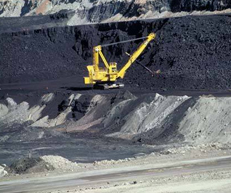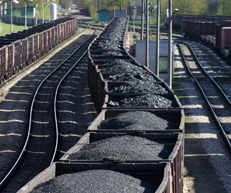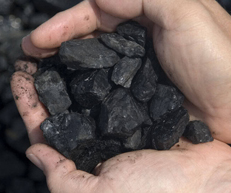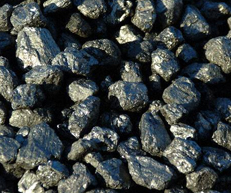Formation
 Coal begins as layers of plant matter accumulating at the bottom of a body of water.
For the process to continue, the plant matter must be protected from biodegradation
and oxidization, usually by mud or acidic water. This trapped atmospheric carbon in
the ground in immense peat bogs that eventually were covered over and deeply buried
by sediments under which they metamorphosed into coal. Over time, the chemical and
physical properties of the plant remains were changed by geological action to create a
solid material.
Coal begins as layers of plant matter accumulating at the bottom of a body of water.
For the process to continue, the plant matter must be protected from biodegradation
and oxidization, usually by mud or acidic water. This trapped atmospheric carbon in
the ground in immense peat bogs that eventually were covered over and deeply buried
by sediments under which they metamorphosed into coal. Over time, the chemical and
physical properties of the plant remains were changed by geological action to create a
solid material.
The wide shallow seas of the Carboniferous period provided ideal conditions for coal formation, although coal is known from most geological periods. The exception is the Coal gap in the Lower Triassic, where coal is incredibly rare: presumably a result of the mass extinction which prefaced this era. Coal is even known from Precambrian strata, which predate land plants: this coal is presumed to have originated from algal residues.
Coal, a fossil fuel, is the largest source of energy for the generation of electricity worldwide, as well as one of the largest worldwide anthropogenic sources of carbon dioxide releases. Gross carbon dioxide emissions from coal usage are slightly more than those from petroleum and about double the amount from natural gas. Coal is extracted from the ground by mining, either underground by shaft mining through the seams or in open pits.

 Coal is primarily used as a solid fuel to produce electricity and
heat through combustion. World coal consumption was about
6.75 billion short tons in 2006[ and is expected to increase 48%
to 9.98 billion short tons by 2030. China produced 2.38 billion
tons in 2006. India produced about 447.3 million tons in 2006.
68.7% of China's electricity comes from coal. The USA consumes
about 14% of the world total, using 90% of it for generation of
electricity.
Coal is primarily used as a solid fuel to produce electricity and
heat through combustion. World coal consumption was about
6.75 billion short tons in 2006[ and is expected to increase 48%
to 9.98 billion short tons by 2030. China produced 2.38 billion
tons in 2006. India produced about 447.3 million tons in 2006.
68.7% of China's electricity comes from coal. The USA consumes
about 14% of the world total, using 90% of it for generation of
electricity.
 Coke is a solid carbonaceous residue derived from low-ash, low-
sulfur bituminous coal from which the volatile constituents are
driven off by baking in an oven without oxygen at temperatures
as high as 1,000 °C (1,832 °F) so that the fixed carbon and
residual ash are fused together. Metallurgical coke is used as a
fuel and as a reducing agent in smelting iron ore in a blast furnace. The
coking coal should be low in sulphur and phosphorus so that they do
not migrate to the metal. The product is cast iron and is too rich in
dissolved carbon, and so must be treated further to make steel.
The coke must be strong enough to resist the weight of overburden
in the blast furnace, which is why coking coal is so important
in making steel using the conventional route. However, the
alternative route to is direct reduced iron, where any carbonaceous
fuel can be used to make sponge or pelletised iron. Coke from
coal is grey, hard, and porous and has a heating value of 24.8
million Btu/ton (29.6 MJ/kg). Some cokemaking processes
produce valuable by-products that include coal tar, ammonia, light
oils, and "coal gas".
Coke is a solid carbonaceous residue derived from low-ash, low-
sulfur bituminous coal from which the volatile constituents are
driven off by baking in an oven without oxygen at temperatures
as high as 1,000 °C (1,832 °F) so that the fixed carbon and
residual ash are fused together. Metallurgical coke is used as a
fuel and as a reducing agent in smelting iron ore in a blast furnace. The
coking coal should be low in sulphur and phosphorus so that they do
not migrate to the metal. The product is cast iron and is too rich in
dissolved carbon, and so must be treated further to make steel.
The coke must be strong enough to resist the weight of overburden
in the blast furnace, which is why coking coal is so important
in making steel using the conventional route. However, the
alternative route to is direct reduced iron, where any carbonaceous
fuel can be used to make sponge or pelletised iron. Coke from
coal is grey, hard, and porous and has a heating value of 24.8
million Btu/ton (29.6 MJ/kg). Some cokemaking processes
produce valuable by-products that include coal tar, ammonia, light
oils, and "coal gas". The 930 billion short tons of recoverable coal reserves
estimated by the Energy Information Administration are equal
to about 4,116 BBOE (billion barrels of oil equivalent).[citation needed] The
amount of coal burned during 2007 was estimated at 7.075
billion short tons, or 133.179 quadrillion BTU's. This is an
average of 18.8 million BTU per short ton. In terms of heat
content, this is about 57,000,000 barrels (9,100,000 m3) of
oil equivalent per day. By comparison in 2007, natural gas
provided 51,000,000 barrels (8,100,000 m3) of oil equivalent
per day, while oil provided 85,800,000 barrels per day.
The 930 billion short tons of recoverable coal reserves
estimated by the Energy Information Administration are equal
to about 4,116 BBOE (billion barrels of oil equivalent).[citation needed] The
amount of coal burned during 2007 was estimated at 7.075
billion short tons, or 133.179 quadrillion BTU's. This is an
average of 18.8 million BTU per short ton. In terms of heat
content, this is about 57,000,000 barrels (9,100,000 m3) of
oil equivalent per day. By comparison in 2007, natural gas
provided 51,000,000 barrels (8,100,000 m3) of oil equivalent
per day, while oil provided 85,800,000 barrels per day. Petra Energy has entered into the Coal trading market and
has built relationships with Coal producers in South Africa,
Zimbabwe, Indonesia, Russia and Poland. Petra Energy has
the ability to arrange the full operation to support the physical
trade market including the logistics. Petra Energy has the ability
to supply long term contracts as well as spots.
Petra Energy endeavors to provide different types of Coal to
the Steel, Cement and Power Generation Industries.
For more information, please contact richard@petraenergy.net
Petra Energy has entered into the Coal trading market and
has built relationships with Coal producers in South Africa,
Zimbabwe, Indonesia, Russia and Poland. Petra Energy has
the ability to arrange the full operation to support the physical
trade market including the logistics. Petra Energy has the ability
to supply long term contracts as well as spots.
Petra Energy endeavors to provide different types of Coal to
the Steel, Cement and Power Generation Industries.
For more information, please contact richard@petraenergy.net